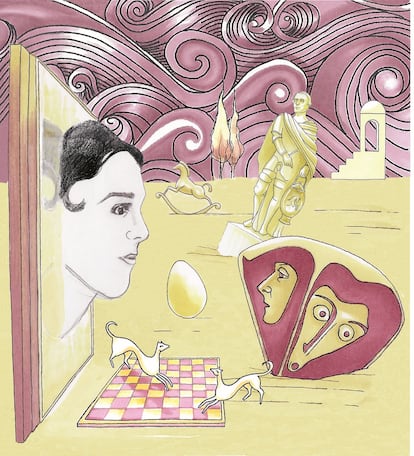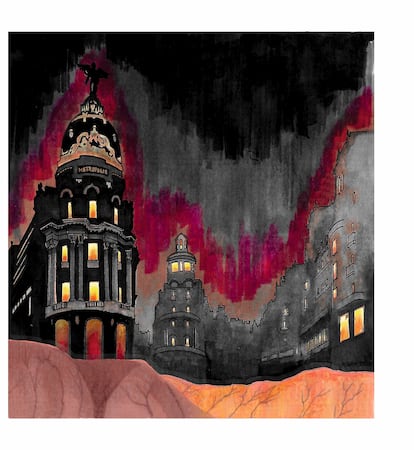When Leonora Carrington died in Mexico City in May 2011, she was 94 years old and was considered one of the great artists of the 20th century. Her paintings populated by women and beasts born in a world of their own, nourished by folklore, religious rituals and the occult, were already well known. Born in Great Britain, she left behind her home in Mexico, her family (the photographer Emeric Weisz and her two sons, Gabriel and Pablo) and, above all, her two best friends and life partners: Remedios Varo and Elena Poniatowska. The three women, Mexican in gratitude to the country that welcomed them, played an essential role in the rich cultural life that the country experienced during the 1950s, 1960s and 1970s. Carrington, born in 1917 in Lancashire (England), was saluted by the world press as the last representative of the surrealist world of André Breton, Man Ray and Joan Miró.
Until then, the general European public had not had the chance to see her work in major exhibitions or to learn many of the details of a life worthy of a true adventure film. It was her friend Poniatowska who delved most deeply into the Englishwoman’s intimate life with the book Leonora (Seix Barral, 2011). In the form of a fictionalised biography, it is the best portrait of the artist that has been published to date. Half a century of intense friendship between the two made possible a book that narrates an exciting life that intersects with that of other great protagonists of the 20th century: Paul Éluard, Salvador Dalí, Pablo Picasso, Marcel Duchamp, André Breton, and the man who was the most important in her life: Max Ernst. The couple had met in the Parisian artistic circles of 1939.
He, a German and already well-known artist, was married and 48 years old. She was only 22 and had a long history of conflicts with her wealthy family. The two left everything and ran away to live their love in Saint-Martin-d’Ardèche, a small town located near Avignon. There they created and lived obeying only their most basic instincts until World War II and the Nazi occupation of France arrived. The Gestapo took him to an internment camp and Leonora launched a frantic race to secure his release.
That abrupt separation is the moment when the graphic novel titled Leonora Carrington in Spain (Turner) with drawings and texts by María Luisa Fruns. The comic joins the wave of events focused on disseminating Carrington’s work, such as the splendid exhibition dedicated to her by Mapfre in February 2023 or the documentary The Surreal Game Produced by Javier Martín Domínguez with an extensive conversation with the artist in her home and in her Mexican studio.
The exhibition, the documentary and Leonora’s own published memoirs (Memories from below) have served María Luisa Fruns to recreate what is considered Leonora Carrington’s Spanish nightmare. The author chose Carrington’s time in Spain because she considers it to be a decisive time in her life. Her stay in Madrid in the midst of the Civil War, the gang rape by some rebels and her transfer by her father to the psychiatric hospital in Santander are the darkest moments of the artist’s life.
The texts and drawings contain Carrington’s own words to describe her reaction when Ernst was taken to the concentration camp by the Gestapo in May 1940: “I cried for several hours in the village, then returned home, where I spent 24 hours making myself vomit with orange blossom water, interrupted by a short nap. I hoped to relieve my suffering with these spasms that shook my stomach like earthquakes.”

Fruns draws Leonora working in the vineyards obsessively, without resting, without eating, and only drinking alcohol. Until one day she is visited by a friend from her opulent British childhood, Katherine Yarrow, and a Hungarian friend, Michel Lukacs, who convince her that she has to leave France and flee to Spain and arrange safe conduct from there. They set off for Andorra in a Fiat. They enter through La Seu d’Urgell to reach Barcelona and from there they take the train to Madrid. During the journey, Leonora feels blocked and stiff. The roads are lined with coffins and the arms and legs of the dead hang from the vehicles in front of them.
In Madrid she looks for officials who can give her a passport or a safe-conduct pass for Max Ernst. Unaware of the terrible effects of the Civil War, in the novel Leonora is seen entering and leaving hotels and walking like a ghost through the streets of a sick city. At the Hotel Roma on Gran Via she meets a Dutch Jew whom she suspects of having relations with the Nazis. Nevertheless, she gives him all her papers. During one of these walks, she meets a group of requetés who drag her to a car. They put her inside and take her to a brick building. They enter, tear off her clothes and rape her again and again. Later, torn and wounded, they release her near the Retiro.
News of Leonora’s situation reaches England. But the only thing the father can think of is to have his daughter admitted to a psychiatric clinic in Santander known for the pro-Nazi methods of its director, Dr. Luis Morales. The worst was yet to come. There they administer cardiazol, the chemical equivalent of electroshock, which causes convulsions for 10 minutes at a time. While the Germans bomb London and she continues to suffer savage sessions of cardiazol, the family sends her nanny and arranges everything so that Leonora receives treatment in a South African clinic. At this point in her misfortune, Carrington has learned to dissimulate and lie. She agrees to go to Lisbon to travel to the place chosen by her father. But first she wants to visit the Prado Museum. It is 1940 and the paintings have returned to Madrid. She immerses herself in Bosch’s creatures and, by chance, meets Renato Leduc, an older diplomat who works at the Mexican Embassy in Lisbon, whom she had met in Paris. The plan is clear: they both decide to marry and travel together to Mexico, the country where Leonora would finally find a world to suit her.

She never met Max Ernst again. After his release, the German fell into the arms of multimillionaire Peggy Guggenheim. Carrington separated from Leduc in 1943 and soon after married Emeric Weisz, a Hungarian photographer who had worked in Paris with Robert Capa. It was Weisz who took three cardboard suitcases full of negatives of photographs of Capa and Gerda Taro from the Spanish Civil War from Paris to Marseille, where he was arrested and sent to an internment camp in Algiers. The negatives, thought lost, reappeared in Mexico City in 2008.
At the end of the novel, Renato and Leonora leave the embassy arm in arm. She is dressed like one of the fantastic creatures from his paintings. She has managed to avoid the fate her family had planned for her and is free again.
